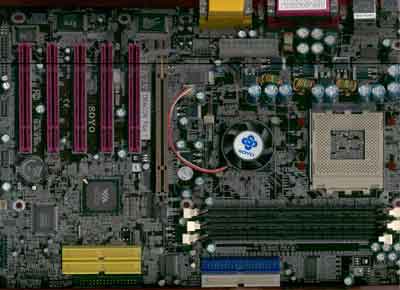VIA KT266A Motherboard Roundup - January 2002
by Mike Andrawes on January 18, 2002 4:48 AM EST- Posted in
- Motherboards
Soyo SY-K7V Dragon Plus!
|
Soyo SY-K7V Dragon Plus! |
|
|
CPU
Interface
|
Socket-A
|
|
Chipset
|
VT
8366A North Bridge
VT 8233 South Bridge |
|
Form
Factor
|
ATX
|
|
Bus
Speeds
|
100
- 233 MHz (1MHz increments)
|
|
Core
Voltages Supported
|
+0.025
/ +0.050 / +0.075 / +0.100 /
-0.025 / -0.050 / -0.075 / -0.100 V |
|
I/O
Voltages Supported
|
Not
Configurable
|
|
DRAM
Voltages Supported
|
Not
Configurable
|
|
Memory
Slots
|
3
184-pin DDR DIMM Slots
|
|
Expansion
Slots
|
1
AGP Pro Slot
5 PCI Slots |
|
Onboard
RAID
|
Promise
PDC20265R
|
|
Onboard
USB 2.0/IEEE-1394
|
N/A
|
|
Onboard
Audio
|
C-Media
CMI8738 PCI Hardware Sound
|
When you first look at the Soyo Dragon Plus! the 5 purple PCI slots really catch your eyes, but it's the list of features the board offers that makes the board stand out from the crowd. In order to make the Dragon Plus! a ready-to-go board Soyo integrated a lot of components to make sure that setting up the system is as easy as it could be.
For on-board audio Soyo also went with the C-Media CMI8738 6 channel PCI chip, which is better than the AC97 audio in terms of number of speakers supported. However, just like the Iwill XP333, Soyo also put in the necessary module so that you can take advantage of the extra channels. Without this module you can only plug in a pair of speakers at the back of the I/O panel, but Soyo made sure you don't have to worry about putting in another external PCI sound card.
Moreover, you also get an integrated LAN support with the Dragon Plus! as well. Soyo took advantage of the integrated VIA 3043 LAN controller inside the VT8233 South Bridge and put the LAN port with the USB ports. With more and more people having broadband access and home networking, this feature definitely comes in handy.
You can also find the Promise PDC20265R controller on the board supporting RAID functions, or you can use it to connect more IDE devices as well. Although smart card systems are not as common here in the US, the included smart card reader is still quite a plus. There are also 4 fan headers on the board so you can put in more cooling fans. Soyo also includes a 200 page manual that contains almost every detail about the board.
The only complaint we have about the board is the 3 DIMMs setup, which limit the flexibility of memory configuration. If Soyo had put in 4 DIMMs instead of three, the board would have gotten much more attention than what it already has.











3 Comments
View All Comments
Anonymous User - Monday, September 29, 2003 - link
How do I get my Engine to Memory clock to run synchronous for my Epox 8kha+ boardxrror - Saturday, August 14, 2021 - link
This was such an exciting time in PC hardware. Intel was still trying to cram Rambus down the industry's throat - and obstinately trying to strong arm the mobo makers and force chipset makers to Rambus licensing. We still had VIA, SiS, ULi, and even nVidia in the chipset market, and with AMD's Athlon line still extraordinarily competitive and Intel in full attack they could no longer just consider AMD as a side-show - this was their leverage against Intel and they had to treat Socket A as premium platform.NegativeROG - Wednesday, June 15, 2022 - link
I still have this board. AND, I invested all of a $10,000 inheritance in Rambus RDRAM. I'm smarter now (I hope). But, you are right about exciting times in the PC space. I navigated away from AMD for a bit, but came back, and will stay forever. Team RED!